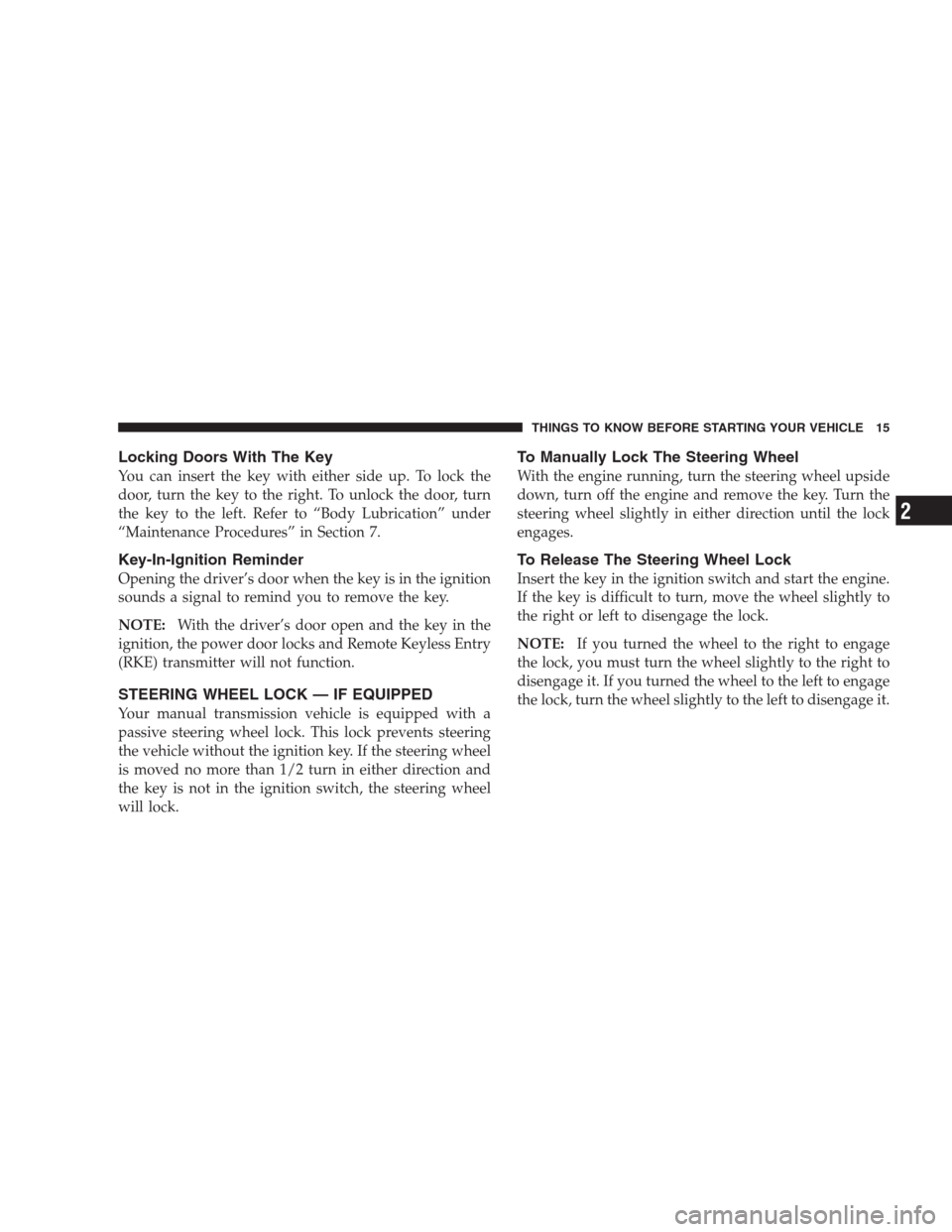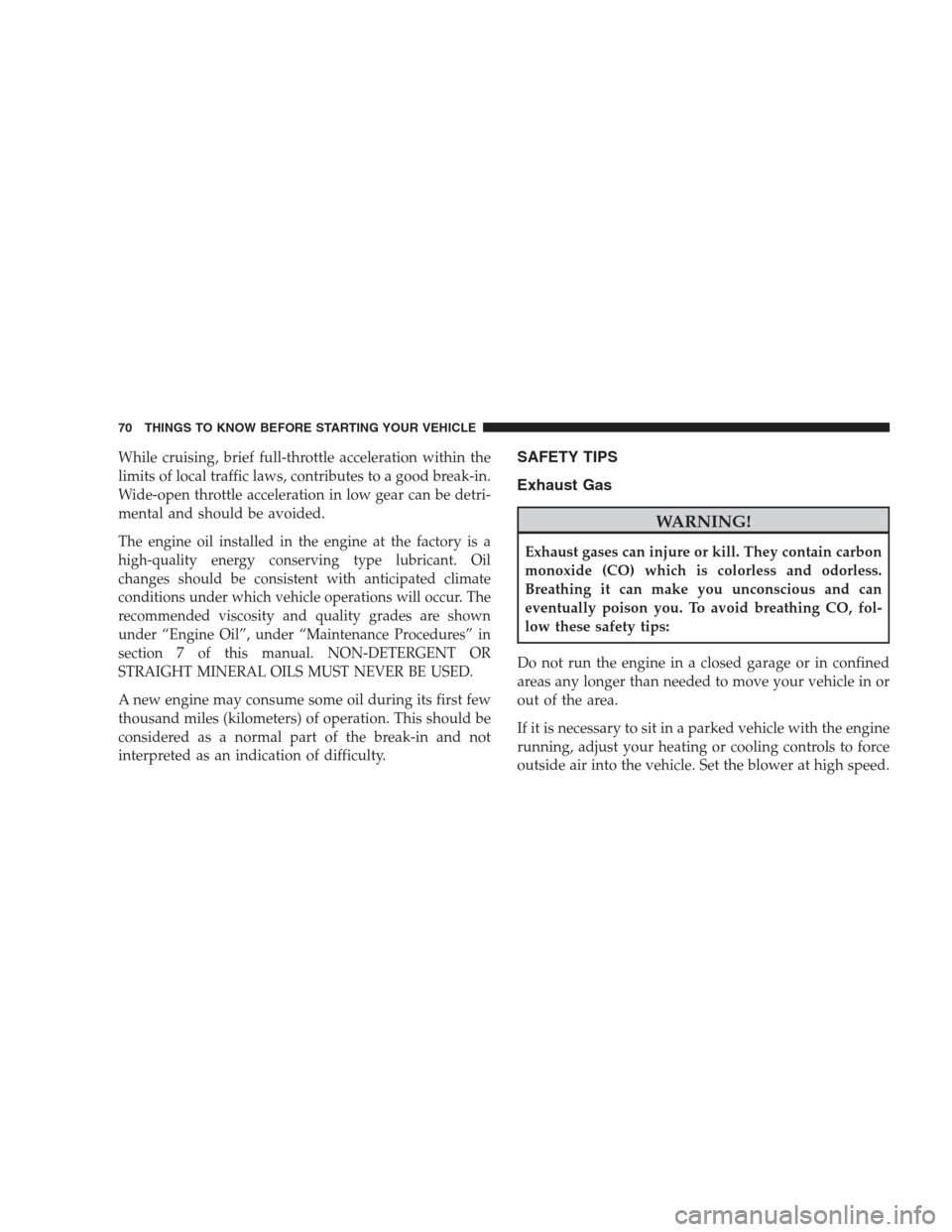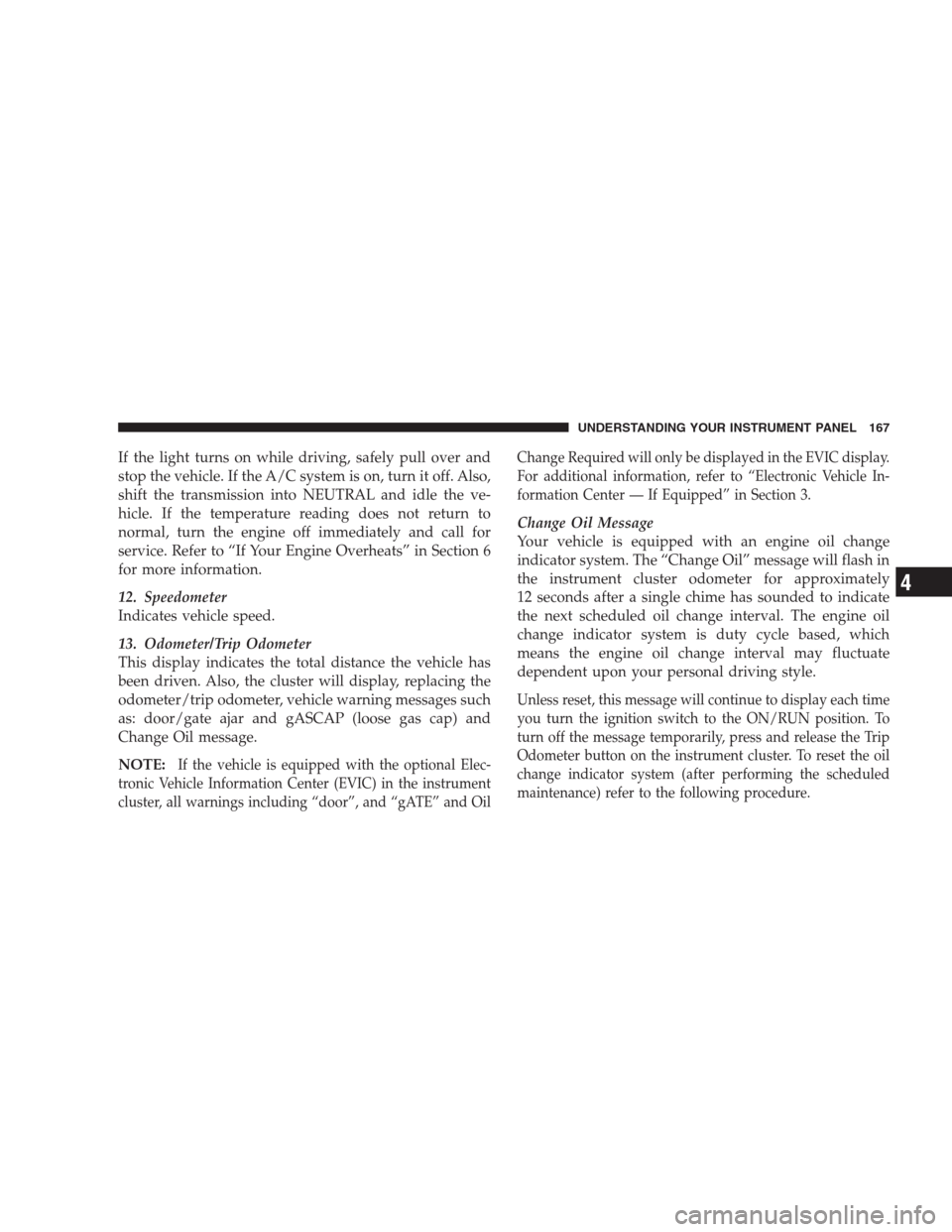Page 3 of 411
TABLE OF CONTENTSSECTIONPAGE
1INTRODUCTION.............................................................3
2THINGS TO KNOW BEFORE STARTING YOUR VEHICLE...............................9
3UNDERSTANDING THE FEATURES OF YOUR VEHICLE...............................73
4UNDERSTANDING YOUR INSTRUMENT PANEL................................... 157
5STARTING AND OPERATING................................................. 247
6WHAT TO DO IN EMERGENCIES...............................................305
7MAINTAINING YOUR VEHICLE............................................... 323
8MAINTENANCE SCHEDULES.................................................. 363
9IF YOU NEED CONSUMER ASSISTANCE..........................................381
10INDEX....................................................................391
1
2
3
4
5
6
7
8
9
10
Page 6 of 411

INTRODUCTION
This Owner’s Manual has been prepared with the assis-
tance of service and engineering specialists to acquaint
you with the operation and maintenance of your vehicle.
It is supplemented by a Warranty Information Booklet
and various customer-oriented documents. You are
urged to read these publications carefully. Following the
instructions and recommendations in this manual will
help assure safe and enjoyable operation of your vehicle.
NOTE: After you read the manual, it should be stored
in the vehicle for convenient reference and remain with
the vehicle when sold, so that the new owner will be
aware of all safety warnings.
When it comes to service, remember that your authorized
dealer knows your vehicle best, has the factory-trained
technicians and genuine Mopar�parts, and is interested
in your satisfaction.
HOW TO USE THIS MANUAL
Consult the Table of Contents to determine which section
contains the information you desire.
The detailed Index at the back of this Owner’s Manual
contains a complete listing of all subjects.
Consult the following table for a description of the
symbols that may be used on your vehicle or throughout
this Owner’s Manual:
4 INTRODUCTION
Page 17 of 411

Locking Doors With The Key
You can insert the key with either side up. To lock the
door, turn the key to the right. To unlock the door, turn
the key to the left. Refer to “Body Lubrication” under
“Maintenance Procedures” in Section 7.
Key-In-Ignition Reminder
Opening the driver’s door when the key is in the ignition
sounds a signal to remind you to remove the key.
NOTE:With the driver’s door open and the key in the
ignition, the power door locks and Remote Keyless Entry
(RKE) transmitter will not function.
STEERING WHEEL LOCK — IF EQUIPPED
Your manual transmission vehicle is equipped with a
passive steering wheel lock. This lock prevents steering
the vehicle without the ignition key. If the steering wheel
is moved no more than 1/2 turn in either direction and
the key is not in the ignition switch, the steering wheel
will lock.
To Manually Lock The Steering Wheel
With the engine running, turn the steering wheel upside
down, turn off the engine and remove the key. Turn the
steering wheel slightly in either direction until the lock
engages.
To Release The Steering Wheel Lock
Insert the key in the ignition switch and start the engine.
If the key is difficult to turn, move the wheel slightly to
the right or left to disengage the lock.
NOTE:If you turned the wheel to the right to engage
the lock, you must turn the wheel slightly to the right to
disengage it. If you turned the wheel to the left to engage
the lock, turn the wheel slightly to the left to disengage it.
THINGS TO KNOW BEFORE STARTING YOUR VEHICLE 15
2
Page 72 of 411

While cruising, brief full-throttle acceleration within the
limits of local traffic laws, contributes to a good break-in.
Wide-open throttle acceleration in low gear can be detri-
mental and should be avoided.
The engine oil installed in the engine at the factory is a
high-quality energy conserving type lubricant. Oil
changes should be consistent with anticipated climate
conditions under which vehicle operations will occur. The
recommended viscosity and quality grades are shown
under “Engine Oil”, under “Maintenance Procedures” in
section 7 of this manual. NON-DETERGENT OR
STRAIGHT MINERAL OILS MUST NEVER BE USED.
A new engine may consume some oil during its first few
thousand miles (kilometers) of operation. This should be
considered as a normal part of the break-in and not
interpreted as an indication of difficulty.
SAFETY TIPS
Exhaust Gas
WARNING!
Exhaust gases can injure or kill. They contain carbon
monoxide (CO) which is colorless and odorless.
Breathing it can make you unconscious and can
eventually poison you. To avoid breathing CO, fol-
low these safety tips:
Do not run the engine in a closed garage or in confined
areas any longer than needed to move your vehicle in or
out of the area.
If it is necessary to sit in a parked vehicle with the engine
running, adjust your heating or cooling controls to force
outside air into the vehicle. Set the blower at high speed.
70 THINGS TO KNOW BEFORE STARTING YOUR VEHICLE
Page 78 of 411

▫Pinch Protect Feature.................. 142
▫Pinch Protect Override................. 142
▫Venting Sunroof — Express............. 143
▫Sunshade Operation................... 143
▫Wind Buffeting...................... 143
▫Sunroof Maintenance.................. 143
▫Ignition Off Operation................. 143
�Electrical Power Outlets................. 144
�Cupholders.......................... 145
�Console Features...................... 146
�Cargo Area Features.................... 147▫Cargo Light/Removable Self-Recharging
Flashlight — If Equipped............... 147
▫Cargo Cover — If Equipped............. 149
▫Removable Load Floor................. 149
▫Cargo Tie-Down Loops................ 150
▫Fold Down Speakers — If Equipped....... 151
�Rear Window Features.................. 152
▫Rear Window Wiper/Washer............ 152
▫Rear Window Defroster................ 153
�Cooled Beverage Storage Bin/Glove
Compartment — If Equipped.............. 154
76 UNDERSTANDING THE FEATURES OF YOUR VEHICLE
Page 145 of 411

Venting Sunroof — Express
Press and hold the “V” button, and the sunroof will open
to the vent position. This is called “express vent”, and
will occur regardless of the sunroof position. During
express vent operation, any movement of the switch will
stop the sunroof.
Sunshade Operation
The sunshade can be opened manually. However, the
sunshade will open automatically as the sunroof opens.
NOTE:The sunshade cannot be closed if the sunroof is
open.
Wind Buffeting
Wind buffeting can be described as the perception of
pressure on the ears or a helicopter-type sound in the
ears. Your vehicle may exhibit wind buffeting with thewindows down, or the sunroof (if equipped) in certain
open or partially open positions. This is a normal occur-
rence and can be minimized. If the buffeting occurs with
the rear windows open, open the front and rear windows
together to minimize the buffeting. If the buffeting occurs
with the sunroof open, adjust the sunroof opening to
minimize the buffeting or open any window.
Sunroof Maintenance
Use only a non-abrasive cleaner and a soft cloth to clean
the glass panel.
Ignition Off Operation
The sunroof will also operate up to 45 seconds after the
ignition has been turned OFF. The sunroof operation will
be canceled if either of the front doors are opened during
the 45 second time period.
UNDERSTANDING THE FEATURES OF YOUR VEHICLE 143
3
Page 162 of 411
�CD/DVD Maintenance.................. 237
�Radio Operation And Cellular Phones....... 238
�Climate Controls...................... 238▫Climate Controls..................... 238
▫Air Filtration System — If Equipped....... 243
▫Operating Tips...................... 244
160 UNDERSTANDING YOUR INSTRUMENT PANEL
Page 169 of 411

If the light turns on while driving, safely pull over and
stop the vehicle. If the A/C system is on, turn it off. Also,
shift the transmission into NEUTRAL and idle the ve-
hicle. If the temperature reading does not return to
normal, turn the engine off immediately and call for
service. Refer to “If Your Engine Overheats” in Section 6
for more information.
12. Speedometer
Indicates vehicle speed.
13. Odometer/Trip Odometer
This display indicates the total distance the vehicle has
been driven. Also, the cluster will display, replacing the
odometer/trip odometer, vehicle warning messages such
as: door/gate ajar and gASCAP (loose gas cap) and
Change Oil message.
NOTE:
If the vehicle is equipped with the optional Elec-
tronic Vehicle Information Center (EVIC) in the instrument
cluster, all warnings including “door”, and “gATE” and OilChange Required will only be displayed in the EVIC display.
For additional information, refer to “Electronic Vehicle In-
formation Center — If Equipped” in Section 3.
Change Oil Message
Your vehicle is equipped with an engine oil change
indicator system. The “Change Oil” message will flash in
the instrument cluster odometer for approximately
12 seconds after a single chime has sounded to indicate
the next scheduled oil change interval. The engine oil
change indicator system is duty cycle based, which
means the engine oil change interval may fluctuate
dependent upon your personal driving style.
Unless reset, this message will continue to display each time
you turn the ignition switch to the ON/RUN position. To
turn off the message temporarily, press and release the Trip
Odometer button on the instrument cluster. To reset the oil
change indicator system (after performing the scheduled
maintenance) refer to the following procedure.
UNDERSTANDING YOUR INSTRUMENT PANEL 167
4